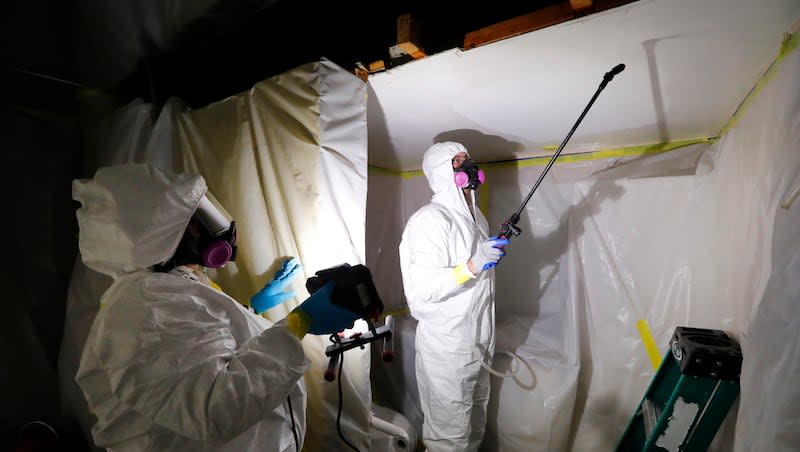All forms of asbestos now banned in U.S.

The Environmental Protection Agency on Monday announced a complete ban with phaseout on asbestos in the United States, years after a partial ban and long after news that asbestos causes cancer. The prohibition of chrysotile asbestos — the last version of asbestos still imported into and used in the U.S. — ultimately bans all asbestos. But not right away.
“With today’s ban, EPA is finally slamming the door on a chemical so dangerous that it has been banned in over 50 countries,” said EPA administrator Michael Regan. “This historic ban is more than 30 years in the making, and it’s thanks to amendments that Congress made in 2016 to fix the Toxic Substances Control Act.”
According to an EPA announcement, the ban is the first rule finalized under the act’s process, “marking an historic milestone for the nation’s chemical safety efforts.” The act, passed in 2016, received almost unanimous support in Congress at the time and tackles tens of thousands of harmful chemicals used in common items from household cleaners to clothes and furniture.
About asbestos
The Centers for Disease Control and Prevention cites lung scarring, lung abnormalities and various cancers, including rare but deadly mesothelioma, ovarian cancer and cancer of the larynx as potential results of exposure. People can get a combination of the conditions. The EPA said asbestos is “linked to more than 40,000 deaths in the U.S. each year.” And the release noted the ban is in line with the government’s Cancer Moonshot Initiative to end cancer.
Asbestos is a mineral fiber found in rock and soil. For many years, the EPA said it was used in building insulation and to make fire retardants, among other uses. As Deseret News reported in October, citing the National Institute for Occupational Safety and Health, “Asbestos fibers have industrial and commercial applications because of their strength, flexibility and electrical and heat-resistant properties.”
At its peak, asbestos was used heavily in construction, including home construction, auto repairs and more. It is sometimes found in vinyl floor tiles, textured paint and heat-resistant fabrics, per the EPA. Asbestos can be inhaled, ingested or exposure may occur through skin contact.
The hold-out chrysotile form of asbestos is used in many products, including gaskets, brake blocks and linings. Asbestos is also used to make sodium hydroxide and chlorine, “a critical use of which is to disinfect drinking water and wastewater,” the EPA release said, noting that there are other ways to disinfect water and also to manufacture chlorine. “In fact, two-thirds of the chlorine produced in the U.S. is produced without using asbestos.”
Time to transition
The eight U.S. plants that do use asbestos diaphragms will be given time to transition so their water treatment doesn’t include asbestos, the EPA said. Companies that have multiple facilities will have up to 12 years to convert all of them, on a timeline schedule that says the first must be transitioned within five years.
The rule also allows a phaseout time for use in specific industries, but says that use in oilfield brake blocks, aftermarket automotive brakes and lining, other friction products, and other gaskets will not be allowed six months from the rule’s effective date.
Per The Associated Press, “The National Association of Clean Water Agencies, which represents 350 publicly owned wastewater treatment agencies, said in a statement that it supports ‘EPA’s efforts to move away from asbestos products’ and will work with the agency to track implementation of the rule. The association warned before the final rule was announced that an immediate ban on asbestos would ‘almost certainly cause shortages and price increases for chlorine and other disinfection and treatment chemicals used by the water sector.’”
According to the article, “The EPA banned asbestos in 1989, but the rule was largely overturned by a 1991 court of appeals decision that weakened the EPA’s authority under TSCA to address risks to human health from asbestos or other existing chemicals. The 2016 law required the EPA to evaluate chemicals and put in place protections against unreasonable risks.”
“The new asbestos ban comes decades after federal lawmakers tried to ban the substance in the 1980s,” according to USA Today. Those efforts were largely struck down in 1991, leading to “more than three decades of inadequate protections,” the White House said Monday.
Asbestos’ funky history
The BBC offers an interesting look into asbestos’ intriguing past, where it was touted as a “magic mineral” used to dress kings and a party trick because asbestos items placed in fire came out unharmed but cleaner. Asbestos doesn’t burn. One particularly odd tidbit: Sealed away in a case in the Natural History Museum of London is an asbestos purse that belonged to a young Benjamin Franklin.
The article notes that asbestos was in first-century Rome called “live linen” and was sometimes used in towels, shoes and nets. “One account from Ancient Greece describes a golden lamp made for the goddess Athena, which could reportedly burn for a whole year without going out and had a wick made from ‘Carpathian flax’ — thought to be another name for asbestos,” the article said.

